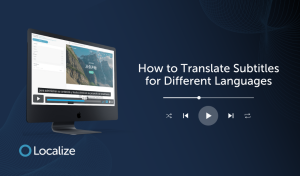Today, many people prefer to watch movies and TV shows with subtitles or captions on. Nobody wants to waste time watching videos with confusing or barely audible audio that they have to decipher. Moreover, subtitling and captioning are now more in demand than ever with the cultural border quickly dissolving when it comes to media consumption. People can now watch and understand videos with foreign audio.
Subtitles and captions may seem to be one and the same for most people, but they do have a significant difference. In fact, even though both forms can be best understood as text versions of audio, they serve very different purposes. Besides, choosing one over the other can have a substantial difference on how your audience views and understands your video. Especially for businesses, whether you choose subtitles or captions depending on your project and purpose can have a huge impact on brand positioning. Read on to learn more about the differences between subtitling and captioning.
Subtitling
So, what is the difference between subtitling and captioning? Subtitles are text alternatives of the spoken dialogue in the video. It is mainly used for translation purposes so that audiences outside the country of origin can understand what is going on. In other words, it is a timed transcription of the audio of a video footage which appears on the screen. Whether it is the dialogue between the actors, a monologue, or a voice-over or narration, subtitles provide the text version.
Subtitles were first introduced sometime in the 1930s, when audio films started becoming popular. They were used as a way to help foreign audiences understand the film by providing text translation of the spoken audio. As such, till today, the main objective of subtitling is to translate spoken audio in videos into another language that intended viewers can comprehend.
Subtitles, unlike captions, assume that the viewer does not have any hearing problems and transcribes the audio files solely for translation purposes. For this reason, only the spoken audio is included in subtitles.
Captioning
Captioning enables even those who are deaf or hard of hearing to enjoy and understand the video. It does this by providing text versions of not only the spoken audio such as dialogues, narration or voice-over in the video file, but also background noises, soundtracks, speaker differentiation as well as other relevant audio parts.
There are two types of captions – open captions and closed captions. Open captions cannot be turned on/off as per the viewer’s wishes, meaning that they are embedded in the video file itself. On the other hand, closed captions can be either turned on or off and are a separate file on their own. For example, the captions you use while watching a movie or show on Netflix are closed captions since you can turn them on and off simply with a few clicks.
Captions were first introduced in the early 70s in the US in order to accommodate the deaf and hard of hearing watching TV. Back then, only open captions were available.
Captions enable viewers to understand every audio in the video, including non-speech sounds. As such, unlike subtitles, their main purpose is not for translating the spoken audio into another language, but rather to enhance the overall-video watching experience for the entire audience, even for those with hearing issues.
Why Use Localize?
With Localize by your side, your business gains a unique advantage in the global digital migration process. We are dedicated to keeping ourselves updated on all translation innovations that will enable your business to succeed in the IoT world. Get in touch with us today and join more than 500 companies in being satisfied clients of all kinds of translation requirements.







